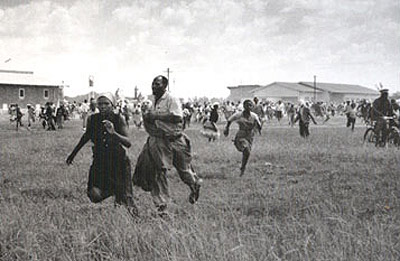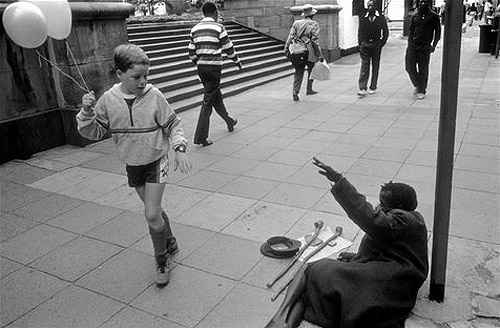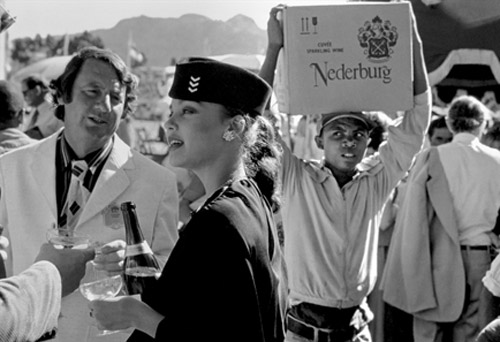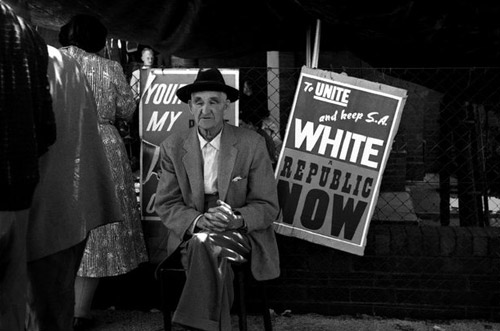
| HOME |
| NERVE |
| REVIEWS |
| ARCHIVE |
| EVENTS |
| LINKS |
| ABOUT US |
| CONTRIBUTORS |
| BACK ISSUES |
| CONTACT US |
 Living
apart: South Africa under Apartheid
Living
apart: South Africa under Apartheid
Photographs by Ian Berry
International
Slavery Museum
8th April 2011 – 6th November 2011
Free admission
Reviewed by Craig Woods
Ian Berry’s unsurpassable exhibition is a unique composition of 90 photos taken over the past forty years that demonstrate how apartheid is far more of an economic system of oppression than simply political. Indeed, it was only when the former began to be affected by the increasingly global and popular revulsion towards the latter, that the political changes began to be made which would earn F.W. De Klerk the Nobel Peace Prize. However, apartheid, in its most vituperative sense, is more alive than ever. Today it is more protected by debt repayments and the constitutional enshrinement of property rights established during the apartheid ‘era’, and a newly independent central Reserve Bank is now free from ‘meddlesome’ governmental interference. As Mandela’s successor, Thabo Mbeki, proudly proclaimed: ‘Just call me a Thatcherite’.
Between 1994 (when ‘power’ was handed over) and 2006: the number of people living in shacks rose by just under 50 per cent; those staying alive on less than a dollar a day more than doubled, as did unemployment; and there was a huge rise in evictions (accompanied by people leaving of their own ‘free’ choice). The share of national income earned by the poorest half of the population fell from a detestable 5.4 per cent in 1975 to an ineffable 3.3 per cent in 2001. Meanwhile, the share garnered by the wealthiest 20 per cent increased and the richest 5 per cent now control about 90 per cent of the national wealth. Recently, South Africa has claimed the title from Brazil of being the most unequal country in the world.
 |
Part of Berry’s magnificence lies in the manner in which he so graphically captured many of the crucial moments during the course of this transition. Consider, for example, the Sharpeville massacre in 1960 when 69 peaceful protesters were killed. Berry was the only cameraman present and were it not for his photos the world would undoubtedly have remained largely ignorant. However, thanks to Berry there was evidence to use in the resulting trials that proved the victims’ innocence. Nevertheless, as the excellent documentary by John Pilger, Apartheid did not die, which accompanies Living apart, points out: ‘this atrocity was a clear sign to western business that the population was being disciplined and opposition crushed. Foreign capital poured in and most of it from Britain. Indeed, Britain was the biggest single investor in South Africa, followed by the Americans, who saw their capital return higher profits than anywhere else in the world’.
 |
The photos, however, go beyond simply being taken by somebody who was just lucky to be in the right place at the right time. Instead, they are more of a chronological representation of many of the subtle nuances hidden within the false black and white dichotomy. During the pre-apartheid era such photos portray: white missionary doctors treating coloured patients in a warehouse; black and white miners working together; black teenage boys playing on a whites-only beach to the indifference of a white couple passing by; black policemen menacingly approaching a terrified elderly black protester; an elderly white woman being led by hand to the polling station in 1994 by a black youth; and even coloured people supporting F.W. De Klerk through the fear that they will lose their relatively privileged middle class status. Once the political facade of the economic oppression is unveiled the images begin to change. Suddenly poor whites begin to appear: begging on the streets; living without water or electricity in the former black workers’ quarters; queuing for free food alongside their erstwhile ‘inferiors’ at the Salvation Army; undergoing military training with the Afrikaner Resistance Movement; and even clashing violently with predominantly white policemen. Meanwhile the super-wealthy white elite, from their fortified citadels, deny ever having supported ‘apartheid’. Their view of the impoverished masses below is conveniently obstructed by a co-opted emerging black middle class.
 |
After viewing many of Berry’s photos from before 1996, Archbishop Desmond Tutu optimistically opined that they were: ‘A searing indictment and an impressive record to counteract amnesia – for those who forget the past are doomed to repeat it’. In a more frustrated tone, Berry later wrote of how: ‘South Africa manages to be both dispiriting in the familiarity of its prejudices and inspiring in its capacity for change’. However, the unfulfilled redistributive potential of the transition away from political apartheid can also be viewed as the most depressing part of the country’s horrific history. Whichever position one chooses to adopt, Living Apart will not fail to provide food for thought and discussion.
Sorry Comments Closed
Comment left by peter njoroge on 1st May, 2014 at 11:07
Apartheid costed black south africans their cultural way of living and brought devastating life living to many even today it has effects which have not been solved.